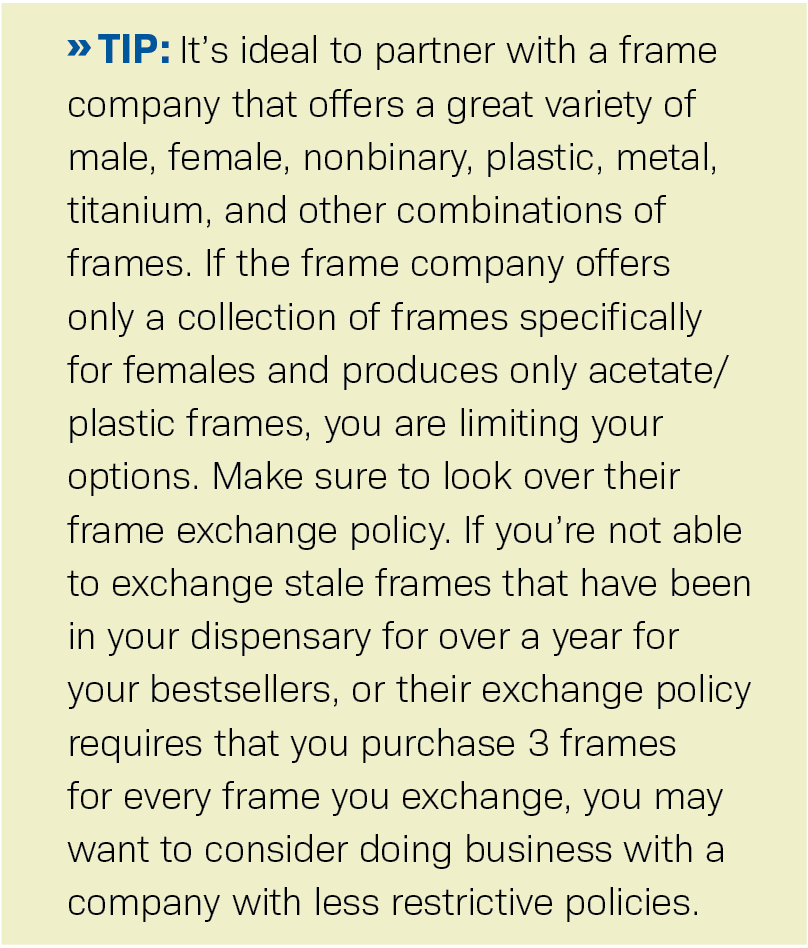Taking your practice revenue to the next level
What 1 doctor did to increase their capture rate to over 80%.
Prescribe and recommend the best lenses and treatments, have the proper frame inventory, and empower your staff with the appropriate training and you will reach a higher capture rate in no time. (Adobe Stock / Allistair F/peopleimages.com)

The average capture rate for optometric practices is around 50% to 55%.1 In our practice, we have been able to maintain over 80% capture rate for the past year despite a global pandemic and inflation.
As optometrists, we graduate from optometry school feeling confident about caring for our patients’ vision and eye health; however, we sometimes need more help on the retail side of our practice. As a practice owner, you must balance your eye care clinic and a retail dispensary. Some may say this is running 2 separate businesses.
Here are 3 steps my practice took to achieve a high capture rate in our optical.
Step 1: Prescribe and recommend the right lenses for your patients.
Your patients come to you with their eye concerns. If your patient shares with you on their intake form or in the exam room that they experience sensitivity to light and glare, reassure them you address all their concerns. Listen carefully and ask clarifying questions. As eye care providers, we are responsible for prescribing and recommending the best for all patients regardless of their socioeconomic status.
I will never forget the day a patient complained about how sensitive she was to light indoors and outdoors. She also said she had always wanted to have prescription sunglasses. When I explained that her vision plan would cover only 1 pair of eyeglasses, she told me that I was her eye doctor and not her financial adviser and that I should stick to my day job as an optometrist and leave her finances to her. If she felt she needed something for her eyes, she would happily pay for it. After that experience, I never make any assumptions and always recommend the best treatments and lenses for every patient. If you’re not prescribing and recommending lenses and treatments to your patients that you know will help them, you are doing your patients a disservice as an eye care professional.
There is no “1 perfect pair” of eyewear. All patients should have their everyday pair, and with technology nowadays, they should have a pair of computer eyeglasses. Ensure that all your patients protect their eyes from harmful UV rays, recommending photochromics and/or prescription polarized sunglasses for patients who want dark lenses behind the windshield at all times with minimal glare.
By recommending these multiple pairs of eyeglasses to each patient, you know you have done your job as their eye care professional to protect their vision. If your patient needs safety eyewear for work or sports, make sure you also make these recommendations.
Recommend reading glasses to patients who enjoy reading for hours, in addition to their everyday glasses. Your patient will appreciate these intentional recommendations. Suppose you don’t make these recommendations and your patient goes to another optometrist who does. In that case, the patient might assume you weren’t paying attention to their needs, were not informed or educated on different lenses and treatment options, or didn’t care—none of which is good for you or your practice.
If your patient shares that they love fashion and the latest in eyewear and lenses, recommend the latest in photochromic lenses in different colors or mirrored lenses to go with different outfits.
Most of our patients keep returning because we have curated an eyewear wardrobe for them. Just like we have multiple outfits in our closet, we should also have multiple pairs of glasses to go with those outfits. Once your patient has the mindset that “1 pair of glasses is not enough,” they will keep coming back for more pairs to complete their eyewear and sun wear wardrobe. This will result in raising your practice capture rate dramatically.
Step 2: Offer the right frame inventory to your patients.
Having the right product for your target market is critical in retail. And, like it or not, we operate in a retail environment. Most practice owners need a better strategy when selecting their frame stock. Not offering the right frame selection will result in your patient leaving with their prescription to go to the optical that does.
Take a moment to look at your patient demographic. Age, sex, what they do for work and play, and their lifestyle. Is your practice in an area that is more rural or urban? If your practice is in a more rural area, you need to ensure that the frame collections you carry and the lenses you prescribe align with your patients’ lifestyles.
For example, reiterating step 1 on prescribing the best lenses for your patient’s frame: Suppose your practice is in a more rural area, and your patients work as farmers and welders. If, as farmers, they spend most of their days outside in the sun, you want to recommend prescription sunglasses and photochromic lenses to protect them from harmful UV rays and provide them with the eye comfort they need to work indoors and outdoors in the scorching sun all day.
Ask your patients about their lifestyles and hobbies so that you can recommend the best frame options for them. If your patients require a frame style that is more practical than fashionable, consider reevaluating your frame inventory. Analyze your current frame offerings and if they do not align with your patient demographic, this may be 1 reason your patients are walking out the doors of your dispensary to go down the street to your competitor. Remember this the next time you decide to bring in a new frame collection.

In our practice, twice a year we run a report with data from sales from our practice management system combining Q1 and Q2 (January through June) and Q3 and Q4 (July through December). We look at essential information such as the percentage of male, female, and nonbinary patients who had eye exams in that time. If, for example, 60% identified as female, 35% as male, and 5% as nonbinary, we ensure our frame stock reflects these percentages. If our frame inventory reflects 60% male, we meet with our frame representatives to create a sales strategy and exchange those frames for more female and nonbinary frame styles to meet the needs of our patients.
You can build a reputation and become known for your unique eyewear selection. People have a desire to buy something that makes them feel unique and you can meet that demand by supplying eyewear they can’t find in every other optical.
Do some research and check out the frame offerings of your local optical competitors and your online competitors. Are you offering unique frames or frames your competitors don’t offer? Are you making it easy for your patients to purchase based on price alone? You want to avoid competing on price to run a sustainable, successful, profitable optical dispensary. Instead, offer your patients a curated collection of frames that wow them in a way that they wouldn’t even consider going anywhere else to purchase their eyeglasses.
Step 3: Empower your staff with training.
Training doesn’t have to be tedious or go on for hours and days. Short, 20-minute training with a 10-minute Q&A to answer any clarifying questions is all you need once a week. If your staff has no questions after the 20-minute training, they can practice what they learned by role-playing with each other. Make sure it is consistent every week without fail. Consistency is key. Author Gino Wickman explains the importance of a structured, weekly, consistent staff meeting in his book “Traction: Get a Grip on Your Business.”
Here are some 20-minute training ideas you can implement immediately:
» Practice how to answer the phone and wow each patient who calls.
» Review processes and procedures that staff have challenges with.
» Explain the different types of photochromic lens options and colors.
» Review benefits of progressive lenses vs bifocals or trifocals.
» Learn how to train new progressive wearers to adapt to their new lenses.
» Learn how to adjust frames when patients come to pick up their eyewear.
» Know the advantages of owning a pair of prescription sunglasses.
» Know the advantages of owning a computer eyeglasses for work.
» Go over a script explaining to patients why a pair of backup glasses is vital for full-time contact lens wearers.
EduMe, a mobile training company, shares why a training program is so crucial for employee retention and great customer service:
“Training programs help employees understand self-worth and build their confidence for the job. People (staff) will appreciate their environment and stay where they are valued because they feel wanted and appreciated by their employers. A valued employee shows concern for their work and will make extra effort to see it through. By providing your employees with new skills and experience, they will not just become better at their jobs, but they will embody the core values of the organization as well.”2

Employees have a higher retention rate and are happier with a job that empowers them at work vs those that don’t. When staff members feel that they are knowledgeable, they feel empowered. Training your staff is 1 step forward to helping them feel appreciated. Your patients will also benefit from your staff’s happiness at work and their knowledge. On the other hand, if you feel that training your staff is inconvenient—or you fear that training them well will lead to getting recruited by your competitor—remember this: What if you train your staff and they leave to work for your competitor? But what if you don’t train your staff and they stay? The latter is not a great scenario.
In summary, prescribe and recommend the best lenses and treatments, have the proper frame inventory, and empower your staff with the appropriate training and you will reach a higher capture rate in no time.
References
1. How to calculate and increase your optical capture rate. First Insight. July 6, 2021. Accessed July 31, 2023. https://www.first-insight.com/blog/calculate-increase-optical-capture-rate/#:~:text=Unfortunately%2C%20many%20patients%20who%20come
2. The importance of a training program for employee retention. eduMe. Accessed July 31, 2023. https://www.edume.com/blog/the-importance-of-a-training-program-for-employee-retention#:~:text=Training%20programs%20help%20employees%20understand

Newsletter
Want more insights like this? Subscribe to Optometry Times and get clinical pearls and practice tips delivered straight to your inbox.